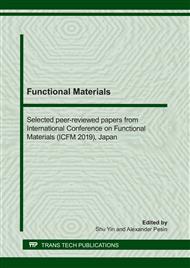p.3
p.9
p.15
p.21
p.27
p.33
p.39
p.45
Preparation and Characterization of Carrot Nanofiber and their Reinforced Nanocomposite Films
Abstract:
In this study, the cellulose nanofiber (CNF) was prepared using carrot slag discarded from industrial carrot juice. The FTIR results of the carrot fiber show that the impurities such as lignin have been removed after alkali and acid neutralization treatment. In addition, it was confirmed that the carrot nanofiber was successfully prepared by the 2,2,6,6-tetramethylpiperidine (TEMPO) radical oxidation method. Subsequently, the obtained nanofiber was surface modified by styrene suspension polymerization and silane coupling agent, respectively. The results of water contact angle analysis show that the hydrophobicity of the modified nanofibers was improved. Moreover, a set of nanocomposite films were prepared by incorporating carrot nanofiber into sodium alginate (SA) and polystyrene (PS), respectively by using solution casting method. The obtained results showed that the TEMPO radical oxidized nanofiber containing film had the best transmittance in SA nanocomposite series. On the other hand, styrene suspension polymerization modified nanofiber containing one exhibited the best transparency in PS nanocomposite series.
Info:
Periodical:
Pages:
15-20
Citation:
Online since:
May 2020
Keywords:
Price:
Сopyright:
© 2020 Trans Tech Publications Ltd. All Rights Reserved
Share:
Citation:


